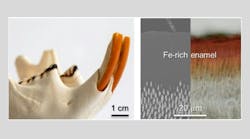New insights about rodent enamel could improve human dentistry
A newly published study in ACS Nano found something surprising about rodent teeth and could have implications for the next generation of preventive and restorative products.
The enamel of rodent teeth has long been known to be enriched with iron, which was also thought to give them their signature brown color. Rodent teeth are harder and also more acid-resistant than human teeth.
The study’s main author, Vesna Srot, and her colleagues, captured high-resolution microscope images of incisor specimens from several species of rodents, including beavers, coypus, squirrels, marmots, rats, voles, and mice.
According to a press release from the American Chemical Society, “elemental composition and color transmission of the enamel, thin slices were taken from different sections of the teeth and prepared for imaging with optical microscopy, 3D focused ion beam tomography and scanning transmission electron microscopy.”
The images revealed how iron is incorporated on a cellular level into rodent enamel as it develops, occupying empty spaces between hydroxyapatite crystals.
Perhaps the most critical insight from these images is that “the intense orange-brown color of rodent incisors doesn’t come from the filled pockets in the enamel, as was previously thought, but from a thin surface layer composed of aromatic amino acids and inorganic minerals.”
“The researchers suggest that adding small amounts of ferrihydrite-like or other colorless biocompatible iron minerals to dental care products could provide exceptional protection for human tooth enamel,” says the press release. “In addition, incorporating small amounts of iron hydroxides into synthetic enamel could produce longer-lasting restorations for human teeth.”
Access the complete study, “Ingenious architecture and coloration generation in enamel of rodent teeth.”
Amelia Williamson DeStefano, MA, is group editorial director of the Endeavor Business Media Dental Group, where she leads the publication of high-quality content that empowers oral-health professionals to advance patient well-being, succeed in business, and cultivate professional joy and fulfillment. She holds a master's in English Literature from the University of Tulsa and has worked in dental media since 2015.









